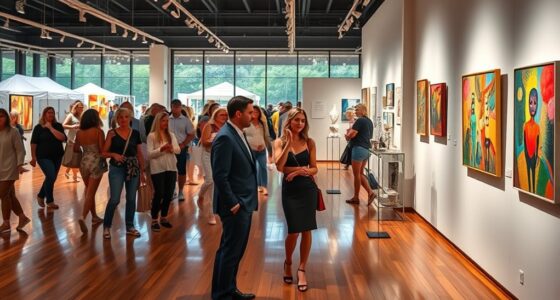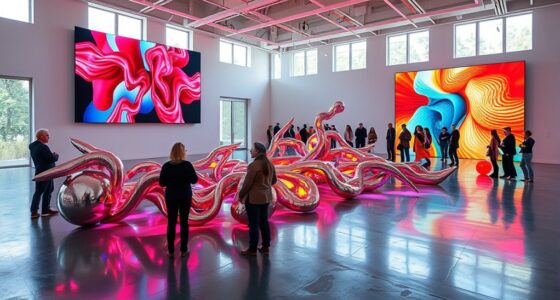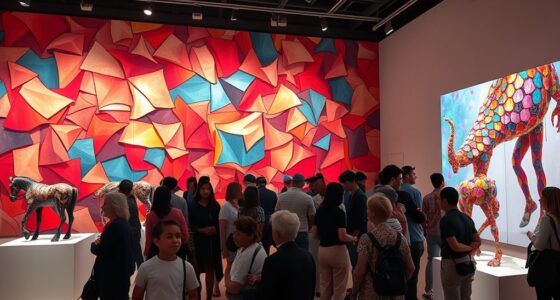Installation art surrounds you with immersive environments that actively draw you in, transforming ordinary spaces into engaging, multisensory experiences. You’re encouraged to move, touch, and interact with the artwork, making each encounter unique. These works use scale, light, sound, and materials to evoke emotions and challenge traditional notions of art. As you explore, you’ll discover how perception, interaction, and space combine to create powerful environments—if you continue exploring, you’ll uncover even more about this enthralling art form.
Key Takeaways
- Installation art creates immersive environments that actively engage viewers through sensory experiences and spatial manipulation.
- It encourages viewers to participate physically, touching, moving through, or influencing the environment for personalized interactions.
- Techniques like lighting, sound, scale, and technology deepen emotional and perceptual engagement within the constructed space.
- These artworks transform traditional boundaries, turning spaces into experiential narratives that blur art and environment.
- Installation art emphasizes perception, interaction, and environment, inviting exploration and redefining how audiences experience contemporary art.

Have you ever stepped into a space that completely transforms your perception of art? That’s the magic of installation art. Unlike traditional artworks, installation art invites you to become an active participant in the experience. It surrounds you, blurs boundaries, and creates an environment where your senses are engaged on multiple levels. As you move through these immersive environments, you’re no longer just observing; you’re part of the artwork itself. This interaction fundamentally alters your spatial perception, making you aware of how space influences emotion and meaning. The artist designs these spaces to challenge your expectations and encourage exploration, often using scale, light, sound, and materials to craft a setting that feels both familiar and surreal.
Experience art as an immersive environment that engages your senses and transforms your perception.
In installation art, the role of the interactive viewer is central. You’re encouraged to move, touch, and even influence the environment in some cases. This active engagement makes the experience personal and dynamic. For example, you might find yourself walking through a maze of hanging objects that respond to your presence with movement or sound, or you could be surrounded by projections that shift as you change your position. These interactions heighten your awareness of how spatial perception shapes your understanding of the space. The artist intentionally designs these environments to provoke curiosity and invite discovery, making each visit unique depending on how you navigate and interpret the installation. Recognizing the importance of perception and interpretation can deepen your connection to the artwork and enhance your overall experience. Additionally, incorporating artistic techniques can elevate the immersive nature of the environment by engaging multiple senses.
Understanding emotional support can also enhance your experience by allowing you to connect more deeply with the artwork, especially when it evokes feelings or memories. The essence of installation art lies in its ability to transform a space into an experiential narrative. You’re no longer a passive viewer but a co-creator of the experience. Your physical movements influence how you perceive the environment, and in turn, how the environment responds can evoke emotional reactions. This dynamic relationship between you and the artwork emphasizes the importance of spatial perception—how your brain processes the dimensions, proximity, and scale of the environment. Artists manipulate these elements to evoke feelings of wonder, disorientation, or intimacy. Incorporating visual fidelity can heighten the immersive experience by creating more realistic and engaging environments. For example, the use of technology in installation art can further enhance the sense of realism and depth, making the environment even more compelling. As you immerse yourself, you become acutely aware of your own body in relation to the space, gaining a deeper understanding of how spatial relationships can be manipulated to communicate complex ideas.
Ultimately, installation art offers a unique way to rethink the boundaries of art and space. It transforms galleries, public places, and even outdoor areas into living, breathing environments that challenge your perceptions and invite participation. When you step into these carefully crafted worlds, you discover that art isn’t just something to look at—it’s an experience to inhabit. And in doing so, you gain a new perspective on how space, perception, and interaction intertwine to create meaningful, memorable encounters.
Frequently Asked Questions
How Do Installation Artists Choose Their Materials?
When choosing materials, you consider your material selection carefully, focusing on how they help convey your concept. Aesthetic considerations play a key role, guiding you to pick textures, colors, and forms that enhance the immersive experience. You might experiment with unconventional objects or sustainable resources, ensuring the materials align with your message and desired atmosphere. Ultimately, your choices shape the viewer’s emotional response and deepen their engagement with your installation.
What Is the History Behind Immersive Installation Environments?
Imagine a journey through a shifting landscape—this mirrors the historical development of immersive installation environments. You’ll see their roots in early experimental art, influenced by cultural shifts like the rise of modernism and technology. Over time, artists crafted spaces that envelop viewers, transforming passive spectators into active participants. These environments reflect a blend of history and culture, evolving into powerful tools for engagement and reflection in contemporary art.
How Do Viewers Typically Interact With Installation Art?
You often find yourself engaging actively with installation art through audience participation, which invites you to become part of the experience. The artwork’s immersive design encourages sensory engagement, making you see, hear, or even touch different elements. Instead of passively observing, you’re immersed in the environment, influencing how you perceive the piece. This interactive approach transforms your visit into a personal, memorable encounter with the artwork.
What Technologies Are Currently Used in Creating Immersive Installations?
Imagine stepping into a world where you’re fully immersed — that’s what virtual reality and motion sensors create in art. Today, artists combine VR headsets, motion sensors, and interactive projections to craft mesmerizing environments. These technologies respond to your movements, making you a part of the artwork. This fusion of tech transforms passive viewers into active participants, making immersive installations more dynamic and engaging than ever before.
How Do Installations Influence Audience Emotions and Perceptions?
When you experience an installation, it influences your emotional responses and prompts perceptual shifts by immersing you in a carefully crafted environment. These artworks engage your senses, making you feel connected or introspective. As you navigate the space, your perceptions evolve, often challenging your assumptions and evoking strong feelings. This interaction deepens your understanding and emotional engagement, creating a memorable, transformative experience that leaves lasting impressions.
Conclusion
As you experience installation art, you realize how immersive environments transform your perception of space and emotion. Did you know that over 60% of viewers report feeling more emotionally connected to artworks in immersive settings? This statistic highlights how installation art uniquely engages your senses and mind, making every visit memorable. So, next time you step into an installation, remember—you’re not just observing, but actively participating in a dynamic, transformative experience.









